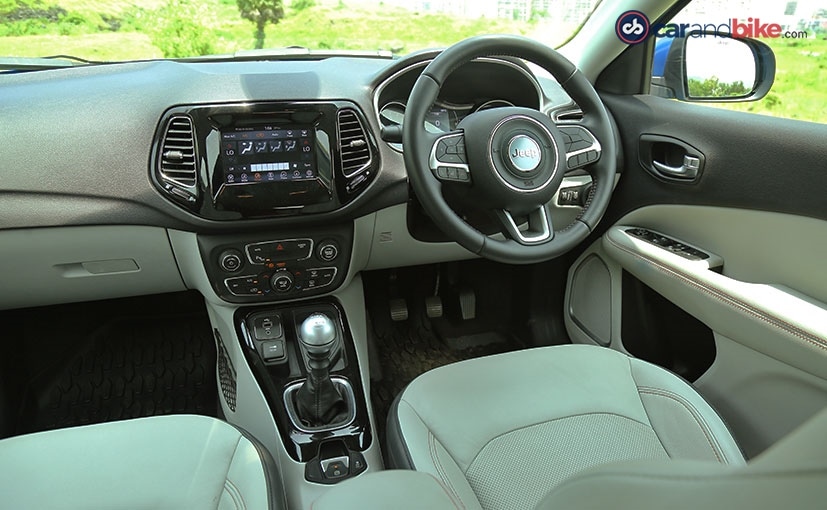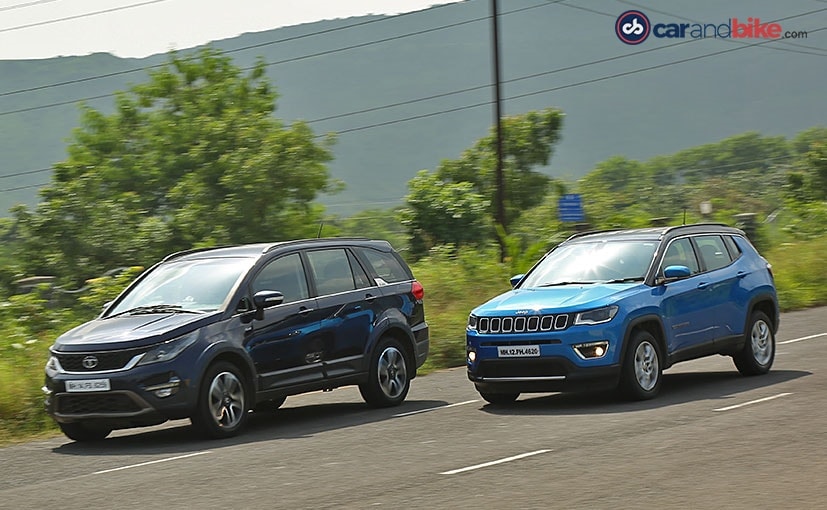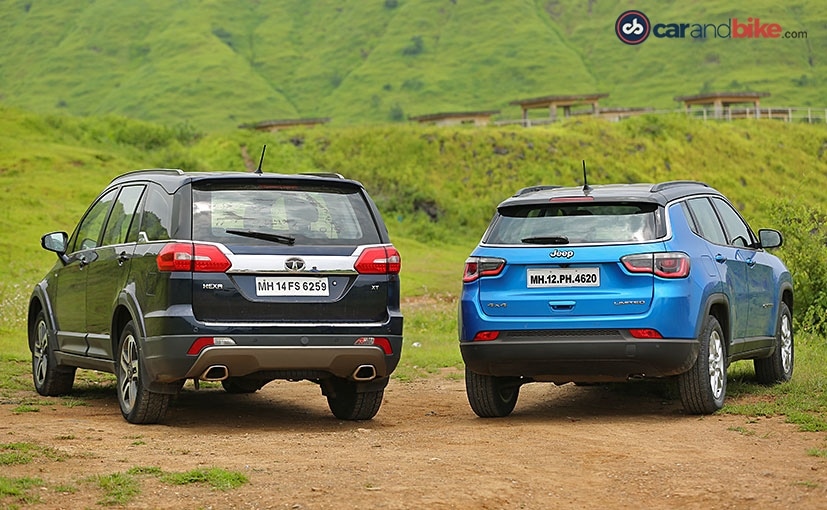Jeep Compass vs Tata Hexa: Comparison Review

Highlights
- Jeep Compass is better looking but Tata Hexa is more butch and imposing
- Tata Hexa is a 7-seater while the Jeep Compass is a 5-seater
- The Compass gets a 2.0 diesel while the Hexa gets a 2.2-litre oil burner
The SUV segment has been the most profitable, in the Indian automobile industry. Take a look at the numbers and you'll see that the sales have gone up, by nearly 15 per cent, in the first half of 2015. Compare that to passenger car growth of close to 6.5 percent and you'll understand what we mean. This is one reason why Jeep launched the Compass, in India, and did so on a war footing. Jeep made sure that it had the right level of localization content, in the car, so that it could price the car well enough, to disrupt the segment.

Tata Hexa has a butch and imposing design
The last time around this segment came under threat, because of disruptive pricing, all fingers pointed at the Tata Hexa. But, earlier when we drove the Hexa, we pitted it against the XUV500 and well it won the bout on the basis of its ride quality, feature list, price and also overall quality. But now, it comes under threat, from the Jeep Compass; and yes it's got a lot to worry about. The Compass gets more power, more features and a petrol engine too. Of course, don't forget the very premium 'Jeep' badge, at a price, which can be termed as 'affordable'. But the Hexa has seven seats on offer, while the Compass has only five' and we wonder if this aspect could tilt the balance, in Hexa's favour.
Also Read: Tata Hexa vs Toyota Innova Crysta - Comparison Review
Tata Hexa is a full-blooded SUV. It is bigger than the Compass, in every manner, and looks butch too, with its imposing blacked out front end, muscular bumper and large wheel-arches housing. But, there's still a bit of MPV splashed on it, which reminds you of the Aria. However, overall, it's a job well done by Tata Motors.

The Jeep Compass looks stylish and like a scaled down version of the Grand Cherokee
The Jeep Compass is a looker too and though you might feel that it's a scaled down version of the Grand Cherokee; frankly, it works in Compass' favour. There's the signature seven-slat grille, along with a squarish bumper and wheel arches, which bring out its 'Jeep' DNA; and though its wheels are smaller than the Hexa, the stance is an imposing one (though we'd like to see bigger wheels than the 17 inchers, it currently has). It's undoubtedly an SUV and something you'll stop to give a second look to.

Jeep Compass comes with good built quality and premium styling
The build quality, on the Compass, is impressive, for most of the part. The chunky steering wheel looks great and feels just as good, to hold. However, the dummy buttons, where the cruise control switches would have gone, look quite odd. The instrument cluster gets large dials and a very informative display unit. And, while white might not be the best colour for upholstery, in India, it certainly does make the interior look quite luxurious.

Tata Hexa's cabin is ergonomically better
In comparison, Tata Hexa's dashboard feels well spaced-out; and you won't find yourself fumbling to find a particular switch. Ergonomically, it's just better. There are a few premium-looking bits and a decent number of storage spaces too; but flimsy plastic bits, like the door locks and seat adjustment levers put you off; and that's where it loses out to the Compass.
Both cars have sufficient leg, knee and headroom; but the Hexa wins the bout, in terms of overall space. What about the engines, though?

Tata Hexa gets a 2.2-litre diesel engine and the Jeep Compass gets a 2-litre diesel engine
The Jeep is a compact car and you feel it, when you sit, in the driver's seat. Under the hood is a 2.0-litre diesel engine, offering 171 bhp and that's more than the Hexa has to offer. However, torque stands at 350 Nm, which is less than that in the Hexa. But, in the Compass, the torque kicks in early, which is why the lag is not an evident one. The ride is pretty good too; as the Compass soaks in the bumps, on the road well; something that you come to expect from an SUV specialist. The steering is precise as well and well weighted. The other engine it comes with is the 1.4-litre Multiair turbo-petrol, which is offered with the choice of a 6-speed manual and a 6-speed dual-clutch transmission. Both engines are offered in 4x4 and 4x2 variants; but the 4x4 system is not like your conventional SUV's unit. The front wheel driven SUV sends power to the rear whenever needed or when the 4x4 lock is engaged. It gets four modes - Auto, Snow, Sand and Mud, as a result of which it can do its fair share of off-roading. The Hexa too can boast of going off the beaten track and it's got driving modes too. The Hexa gets the Auto, Rough Road and Comfort mode and is only available with a diesel engine, but gets both a 6 speed manual and a 6 speed automatic transmission and though it gets a bigger engine than the Compass, it's not as powerful.

Both the Tata Hexa and the Jeep Compass get a 6-speed manual gerbox
When you sit behind the wheel, the Hexa feels like a compact car; but it's only when you look behind that you notice there's a lot more of it and it's quite a large car. The 6-speed manual gear box doesn't like to be changed, it's a bit adamant and to draw a comparison, well it's as adamant as a child, who has to get up early to go to school. You send him/her to school alright, but there's a lot of effort channeled, in that direction. The ride and handling is a big plus point and you get an imposing view of the road. The car is stable, though there's a bit of body roll that you have to deal with; but overall it's not a bad choice, in that segment. So, if the Compass is out of reach, the Hexa is not a bad choice at all.

Tata Hexa and Jeep Compass both come with good amount of safety features
With respect to standard safety features, the Jeep Compass has the edge. While the XUV and the Hexa get ABS and front airbags as standard, only the Compass gets electronic stability control and hill-start assist. In the top-end variant, the Compass gets eight airbags, traction control, cornering lights and adaptive brake lights as well.

Jeep Compass gets a better infotainment system compared to Tata Hexa
As far as features go, the Hexa comes with auto-down windows, cruise control, auto headlamps, automatic wipers, heated ORVM, a very good 10-speaker JBL sound system; but a not-so-good Harman touchscreen system. 'Not-so-good' because it takes a while to get used to it and it's not exactly quick, to respond to your inputs. The Compass misses out on auto headlamps and cruise control, but gets Apple Carplay and Android Auto.

Top-end Jeep Compass is over Rs. 3 lakh more expensive than the top-end Tata Hexa
And, now we come to the price. The fully loaded Hexa 4x4 costs Rs. 17.19 lakh; while the top-end Jeep Compass costs Rs. 21. 37 lakh (both prices ex-showroom Delhi) and even the petrol with all the bells and whistles is close to three lakh more than the Hexa. So, yes, the Hexa is the more value for money car, but in a segment, where consumers are looking for feature rich cars with good build quality and great ride and handling, the Compass wins hands down.
Related Articles
Latest News
Research More on Jeep Compass
- Home
- News
- Auto Industry
- Jeep Compass vs Tata Hexa: Comparison Review



















